automatic transmission DODGE AVENGER 2013 2.G User Guide
[x] Cancel search | Manufacturer: DODGE, Model Year: 2013, Model line: AVENGER, Model: DODGE AVENGER 2013 2.GPages: 108, PDF Size: 3.35 MB
Page 70 of 108
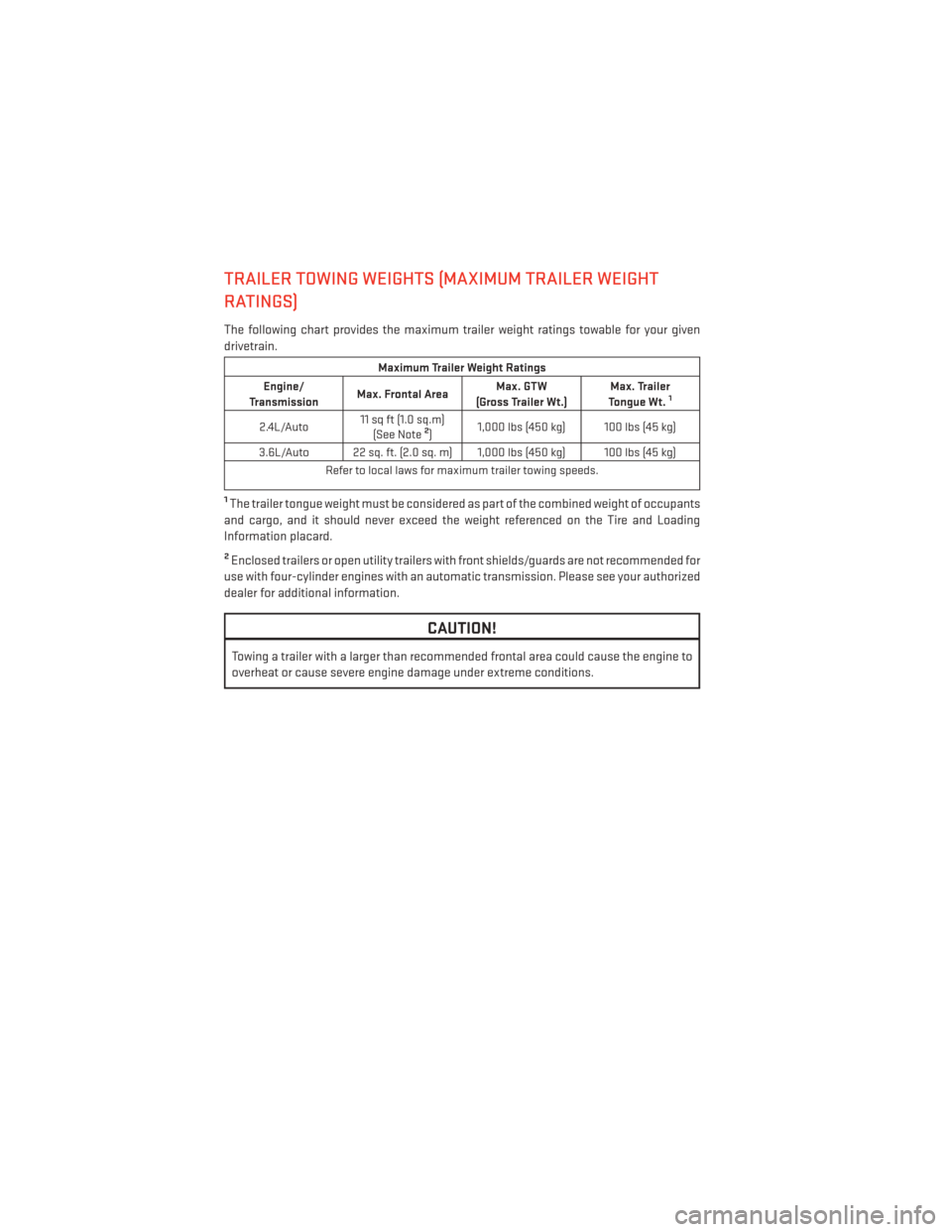
TRAILER TOWING WEIGHTS (MAXIMUM TRAILER WEIGHT
RATINGS)
The following chart provides the maximum trailer weight ratings towable for your given
drivetrain.
Maximum Trailer Weight Ratings
Engine/
Transmission Max. Frontal Area Max. GTW
(Gross Trailer Wt.) Max. Trailer
Tongue Wt.
1
2.4L/Auto 11 sq ft (1.0 sq.m)
(See Note2) 1,000 lbs (450 kg) 100 lbs (45 kg)
3.6L/Auto 22 sq. ft. (2.0 sq. m) 1,000 lbs (450 kg) 100 lbs (45 kg) Refer to local laws for maximum trailer towing speeds.
1The trailer tongue weight must be considered as part of the combined weight of occupants
and cargo, and it should never exceed the weight referenced on the Tire and Loading
Information placard.
2Enclosed trailers or open utility trailers with front shields/guards are not recommended for
use with four-cylinder engines with an automatic transmission. Please see your authorized
dealer for additional information.
CAUTION!
Towing a trailer with a larger than recommended frontal area could cause the engine to
overheat or cause severe engine damage under extreme conditions.
UTILITY
68
Page 77 of 108
JACKING AND TIRE CHANGING
Jack Location
• The jack and jack-handle are stowed under the load floor in the trunk.
Spare Tire Stowage
• The compact spare tire is stowed under the rear load floor in the trunk.
Spare Tire Removal
• Lift up the load floor cover and remove the hold down.
Preparations For Jacking
1. Park the vehicle on a firm, level surface.Avoid ice or slippery areas.
2. Turn on the Hazard Warning flashers.
3. Set the parking brake.
4.
Place the shift lever into PARK (automatic
transmission) or REVERSE (manual trans-
mission).
5. Turn OFF the ignition.
6. Block both the front and rear of the wheel diagonally opposite the jacking position. For example, if changing the right front tire, block the left rear wheel.
NOTE:
Passengers should not remain in the vehicle
while the vehicle is being jacked.
WHAT TO DO IN EMERGENCIES
75
Page 81 of 108
CAUTION!
•Do not attempt to raise the vehicle by jacking on locations other than those indicated
in the Jacking Instructions for this vehicle.
• Be sure to mount the spare tire with the valve stem facing outward. The vehicle could be damaged if the spare tire is mounted incorrectly.
WARNING!
• Being under a jacked-up vehicle is dangerous. The vehicle could slip off the jack and
fall on you. You could be crushed. Never put any part of your body under a vehicle that
is on a jack. If you need to get under a raised vehicle, take it to a service center where
it can be raised on a lift.
• Never start or run the engine while the vehicle is on a jack.
• The jack is designed to be used as a tool for changing tires only. The jack should not
be used to lift the vehicle for service purposes. The vehicle should be jacked on a firm
level surface only. Avoid ice or slippery areas.
• Do not attempt to change a tire on the side of the vehicle close to moving traffic, pull
far enough off the road to avoid the danger of being hit when operating the jack or
changing the wheel.
•
Carefully follow these tire changing warnings to help prevent personal injury or damage
to your vehicle:
• Always park on a firm, level surface as far from the edge of the roadway as pos-
sible before raising the vehicle.
• Turn on the Hazard Warning flasher.
• Block the wheel diagonally opposite the wheel to be raised.
• Set the parking brake firmly and set an automatic transmission in PARK; a
manual transmission in REVERSE.
• Do not let anyone sit in the vehicle when it is on a jack.
• Do not get under the vehicle when it is on a jack.
•
Only use the jack in the positions indicated and for lifting this vehicle during a tire change.
• If working on or near a roadway, be extremely careful of motor traffic.
•
To assure that spare tires, flat or inflated, are securely stowed, spares must be stowed
with the valve stem facing the ground.
•Raising the vehicle higher than necessary can make the vehicle less stable. It could slip
off the jack and hurt someone near it. Raise the vehicle only enough to remove the tire.
• To avoid possible personal injury, handle the wheel covers with care to avoid contact
with any sharp edges.
•
A loose tire or jack thrown forward in a collision or hard stop could injure the occupants
in the vehicle. Have the deflated (flat) tire repaired or replaced immediately.
• To avoid the risk of forcing the vehicle off the jack, do not tighten the lug nuts fully
until the vehicle is lowered to the ground. Failure to follow this warning may result in
personal injury.
WHAT TO DO IN EMERGENCIES
79
Page 82 of 108
BATTERY LOCATION
• The battery in your vehicle is located between the left front headlight assembly and theleft front wheel splash shield. To allow jump-starting there are remote battery posts
located on the left side of the engine compartment.
JUMP-STARTING
• If your vehicle has a discharged battery it can be jump-started using a set of jumpercables and a battery in another vehicle or by using a portable battery booster pack.
Jump-starting can be dangerous if done improperly so please follow the procedures in
this section carefully.
NOTE:
When using a portable battery booster pack follow the manufacturer's operating instruc-
tions and precautions.
Preparations For Jump-Start
• The battery in your vehicle is located between the left front headlight assembly
and the left front wheel splash shield.
To allow jump-starting there are remote
battery posts located on the left side of
the engine compartment.
1. Set the parking brake, shift the automatic transmission into PARK and turn the igni-
tion to LOCK.
2. Turn off the heater, radio, and all unnec- essary electrical accessories.
3. Remove the protective cover over the re- mote positive (+)battery post. To remove
the cover, press the locking tab and pull
upward on the cover.
WHAT TO DO IN EMERGENCIES
80
Page 91 of 108
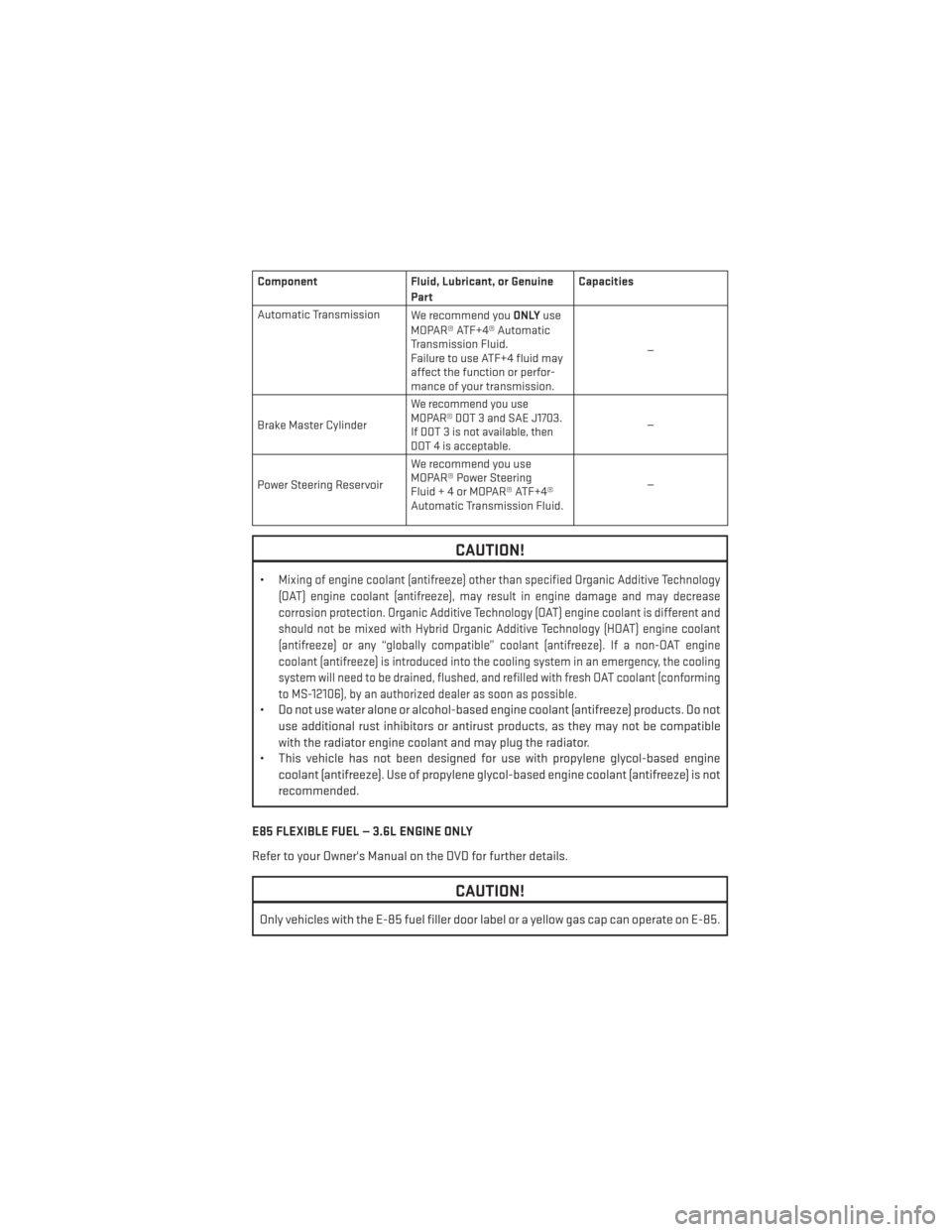
ComponentFluid, Lubricant, or Genuine
Part Capacities
Automatic Transmission We recommend youONLYuse
MOPAR® ATF+4® Automatic
Transmission Fluid.
Failure to use ATF+4 fluid may
affect the function or perfor-
mance of your transmission. —
Brake Master Cylinder
We recommend you use
MOPAR® DOT 3 and SAE J1703.
If DOT 3 is not available, then
DOT 4 is acceptable.
—
Power Steering Reservoir We recommend you use
MOPAR® Power Steering
Fluid+4orMOPAR®ATF+4®
Automatic Transmission Fluid. —
CAUTION!
•Mixing of engine coolant (antifreeze) other than specified Organic Additive Technology
(OAT) engine coolant (antifreeze), may result in engine damage and may decrease
corrosion protection. Organic Additive Technology (OAT) engine coolant is different and
should not be mixed with Hybrid Organic Additive Technology (HOAT) engine coolant
(antifreeze) or any “globally compatible” coolant (antifreeze). If a non-OAT engine
coolant (antifreeze) is introduced into the cooling system in an emergency, the cooling
system will need to be drained, flushed, and refilled with fresh OAT coolant (conforming
to MS-12106), by an authorized dealer as soon as possible.
• Do not use water alone or alcohol-based engine coolant (antifreeze) products. Do not
use additional rust inhibitors or antirust products, as they may not be compatible
with the radiator engine coolant and may plug the radiator.
• This vehicle has not been designed for use with propylene glycol-based engine
coolant (antifreeze). Use of propylene glycol-based engine coolant (antifreeze) is not
recommended.
E85 FLEXIBLE FUEL — 3.6L ENGINE ONLY
Refer to your Owner's Manual on the DVD for further details.
CAUTION!
Only vehicles with the E-85 fuel filler door label or a yellow gas cap can operate on E-85.
MAINTAINING YOUR VEHICLE
89
Page 92 of 108
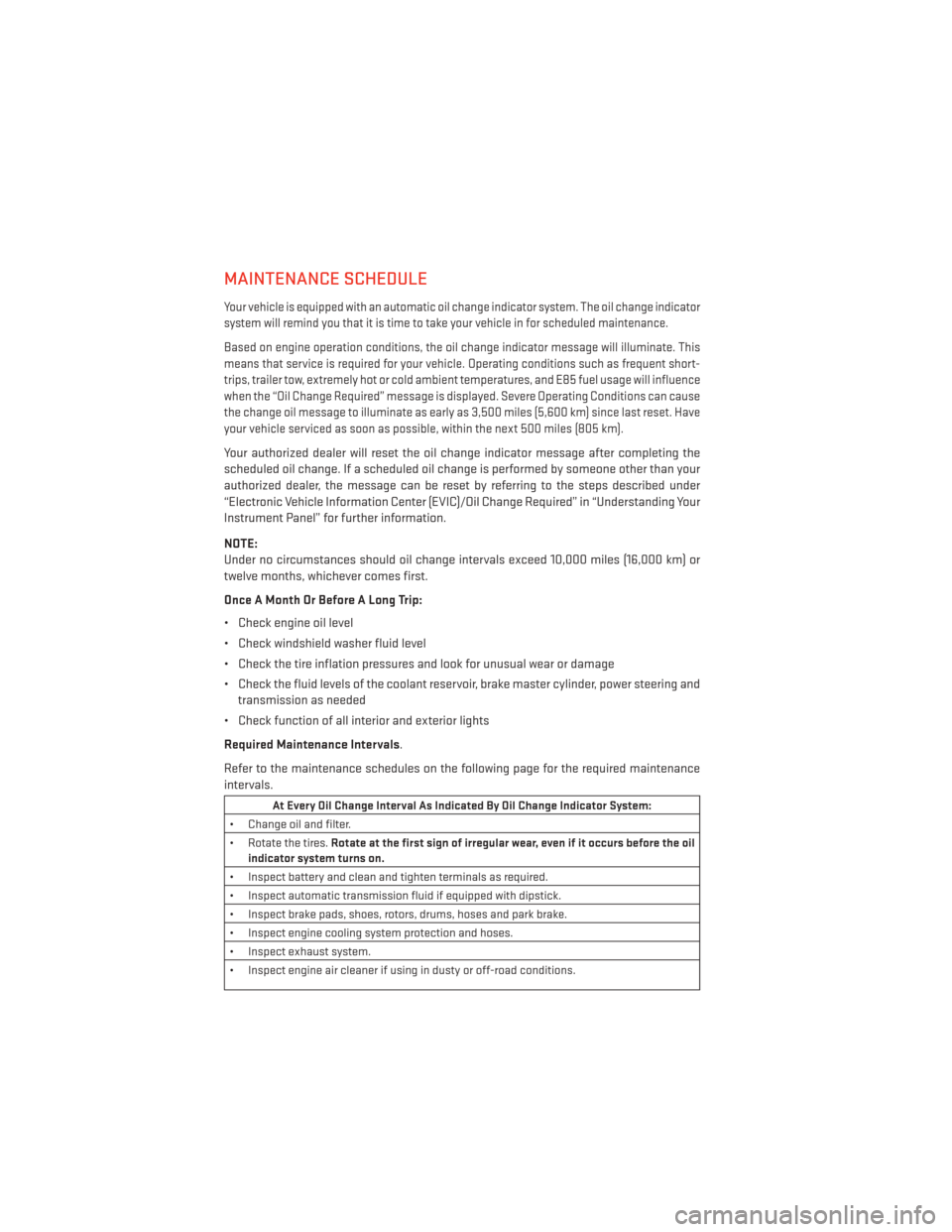
MAINTENANCE SCHEDULE
Your vehicle is equipped with an automatic oil change indicator system. The oil change indicator
system will remind you that it is time to take your vehicle in for scheduled maintenance.
Based on engine operation conditions, the oil change indicator message will illuminate. This
means that service is required for your vehicle. Operating conditions such as frequent short-
trips, trailer tow, extremely hot or cold ambient temperatures, and E85 fuel usage will influence
when the “Oil Change Required” message is displayed. Severe Operating Conditions can cause
the change oil message to illuminate as early as 3,500 miles (5,600 km) since last reset. Have
your vehicle serviced as soon as possible, within the next 500 miles (805 km).
Your authorized dealer will reset the oil change indicator message after completing the
scheduled oil change. If a scheduled oil change is performed by someone other than your
authorized dealer, the message can be reset by referring to the steps described under
“Electronic Vehicle Information Center (EVIC)/Oil Change Required” in “Understanding Your
Instrument Panel” for further information.
NOTE:
Under no circumstances should oil change intervals exceed 10,000 miles (16,000 km) or
twelve months, whichever comes first.
Once A Month Or Before A Long Trip:
• Check engine oil level
• Check windshield washer fluid level
• Check the tire inflation pressures and look for unusual wear or damage
• Check the fluid levels of the coolant reservoir, brake master cylinder, power steering andtransmission as needed
• Check function of all interior and exterior lights
Required Maintenance Intervals.
Refer to the maintenance schedules on the following page for the required maintenance
intervals.
At Every Oil Change Interval As Indicated By Oil Change Indicator System:
• Change oil and filter.
• Rotate the tires. Rotate at the first sign of irregular wear, even if it occurs before the oil
indicator system turns on.
• Inspect battery and clean and tighten terminals as required.
• Inspect automatic transmission fluid if equipped with dipstick.
• Inspect brake pads, shoes, rotors, drums, hoses and park brake.
• Inspect engine cooling system protection and hoses.
• Inspect exhaust system.
• Inspect engine air cleaner if using in dusty or off-road conditions.
MAINTAINING YOUR VEHICLE
90
Page 93 of 108
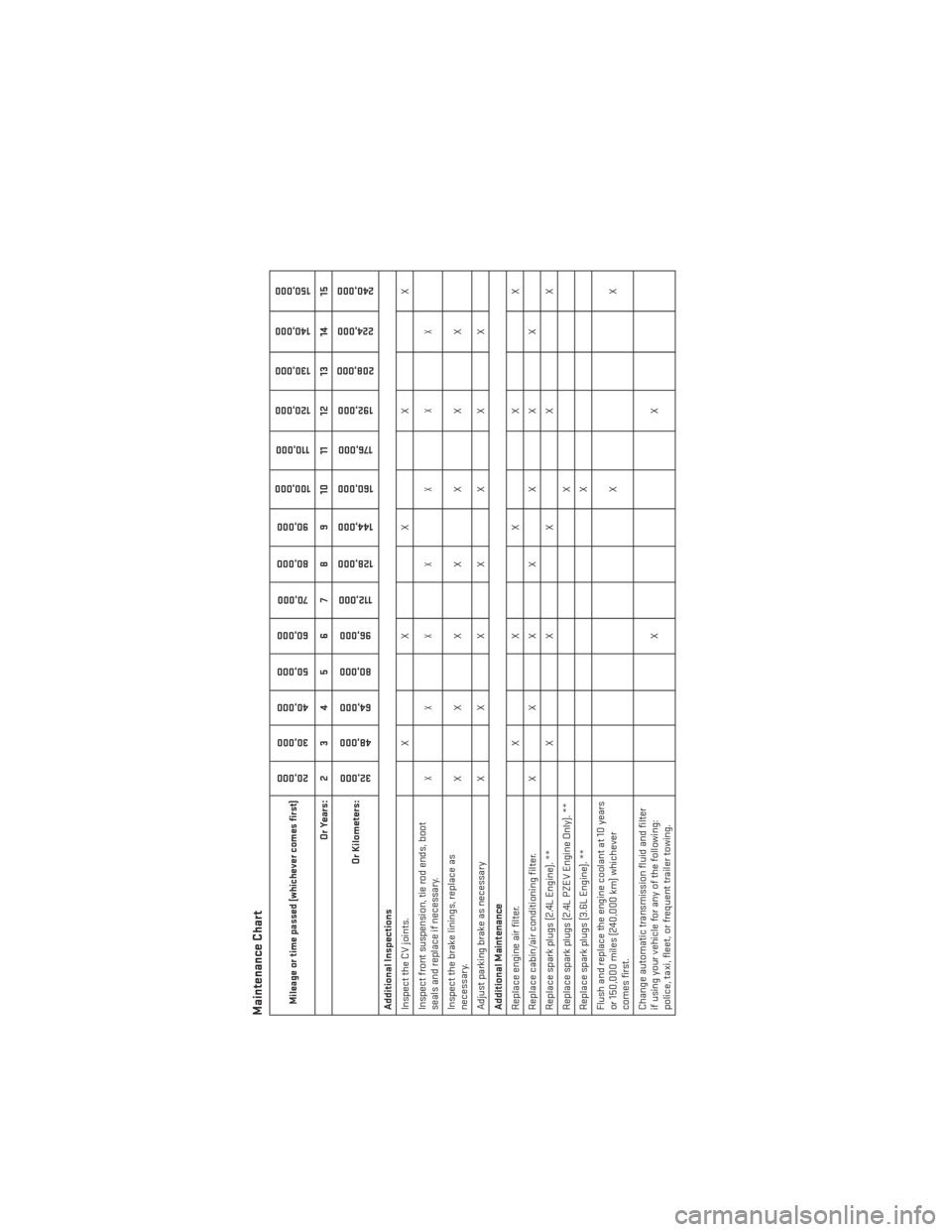
Maintenance ChartMileage or time passed (whichever comes first)
20,00030,000
40,000
50,000
60,000 70,000
80,000
90,000
100,000
110,000
120,000 130,000
140,000
150,000
Or Years: 2 3 4 5 6 7 8 9 10 11 12 13 14 15
Or Kilometers:
32,000
48,000
64,000
80,000
96,000
112,000
128,000
144,000
160,000
176,000
192,000
208,000 224,000
240,000
Additional Inspections
Inspect the CV joints. X X X X X
Inspect front suspension, tie rod ends, boot
seals and replace if necessary.
XXXX X X X
Inspect the brake linings, replace as
necessary. XXXX X X X
Adjust parking brake as necessary XX XX X X X
Additional Maintenance
Replace engine air filter. XX X X X
Replace cabin/air conditioning filter. XX XX X X X
Replace spark plugs (2.4L Engine). ** XX X X X
Replace spark plugs (2.4L PZEV Engine Only). ** X
Replace spark plugs (3.6L Engine). ** X
Flush and replace the engine coolant at 10 years
or 150,000 miles (240,000 km) whichever
comes first. XX
Change automatic transmission fluid and filter
if using your vehicle for any of the following:
police, taxi, fleet, or frequent trailer towing. XX
MAINTAINING YOUR VEHICLE
91
Page 94 of 108
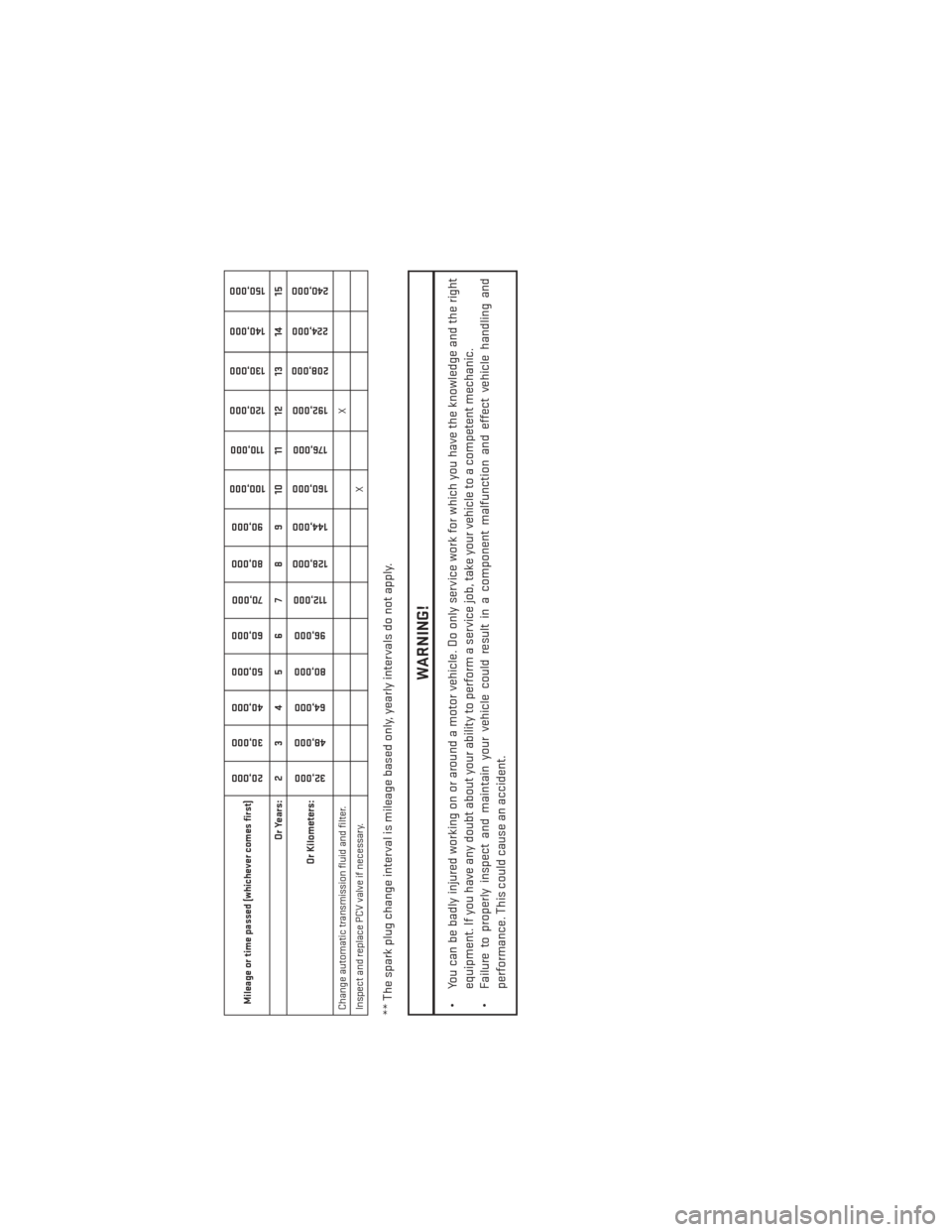
Mileage or time passed (whichever comes first)
20,00030,000
40,000
50,000
60,000 70,000
80,000
90,000
100,000
110,000
120,000 130,000
140,000
150,000
Or Years: 2 3 4 5 6 7 8 9 10 11 12 13 14 15
Or Kilometers:
32,000
48,000
64,000
80,000
96,000
112,000
128,000
144,000
160,000
176,000
192,000
208,000 224,000
240,000
Change automatic transmission fluid and filter. X
Inspect and replace PCV valve if necessary. X** The spark plug change interval is mileage based only, yearly intervals do not apply.
WARNING!
• You can be badly injured working on or around a motor vehicle. Do only service work for which you have the knowledge and the right equipment. If you have any doubt about your ability to perform a service job, take your vehicle to a competent mechanic.
• Failure to properly inspect and maintain your vehicle could result in a component malfunction and effect vehicle handling and
performance. This could cause an accident.
MAINTAINING YOUR VEHICLE
92
Page 103 of 108
Airbag...................10
Air Conditioning.............23
Alarm,Panic................8
Alarm (Security Alarm) ...........9
Arming Theft System (Security Alarm)...9
Automatic Headlights ...........19
Automatic Temperature Control (ATC)...22
Automatic Transmission Fluid Type ..............88
AxleFluid.................88
Belts, Seat .................9
BrakeFluid................88
Brake System Master Cylinder ...........89
Break-In Recommendations, New Vehicle ..............18
Calibration, Compass ...........62
Change Oil Indicator ...........73
Changing A Flat Tire ...........75
Child Restraint ...............11
Child Restraint Tether Anchors ......12
ClimateControl..............22
Compass Calibration ...........62
Cooling System Coolant Capacity ...........88
Cruise Control (Speed Control) ......21
Cruise Light ................21
Customer Assistance ..........98
Defects, Reporting ............99
Dimmer Control ..............19
Dimmer Switch, Headlight ........19
Disarming, Theft System ..........9
Electronics Your Vehicle's Sound System ....26
Electronic Speed Control (Cruise Control) ............21
Electronic Stability Control (ESC) .....70
Electronic Vehicle Information Center (EVIC) .............63
Emergency, In Case of Brake Warning Light .........72
Jacking ................75
JumpStarting ............80 Engine
Break-In Recommendations .....18
Compartment ............86
Coolant (Antifreeze) .........88
Jump Starting ............80
Oil ..................88
Oil Filter ...............88
Oil Selection .............88
Overheating ..............74
EventDataRecorder...........84
Flash-To-Pass ...............19
Fluid, Brake ................89
Fluid Capacities .............88
Fluids ...................88
FogLights.................19
Folding Rear Seat .............15
Freeing A Stuck Vehicle .........83
Front Heated Seats ............16
Fuel Filler Cap (Gas Cap) ..........73
Gasoline ...............88
Specifications ............88
Garage Door Opener (HomeLink®) ....64
Headlights Automatic ..............19
Dimmer Switch ............19
HighBeam ..............19
HeatedMirrors............22,23
Heated Seats ...............
1
6
High Beam/Low Beam Select (Dimmer) Switch ............19
HomeLink® (Garage Door Opener) ....64
Hood Release ...............85
Instrument Cluster Indicators ...............7
Intermittent Wipers (Delay Wipers) ....20
Introduction ................2
iPod®/USB/MP3 Control .........55
Bluetooth Streaming Audio .....62
Jacking Instructions ...........76
Jack Location ...............75
Jack Operation ............75,76
Jump Starting ..............80
INDEX
101